Performing hippos, dancing camels, precarious feats on the high wire are just some of the Azerbaijani circus acts that can be seen around the world today. The Baku circus, which has its own building on Samad Vurgun Street, has fostered many well-known performers over the years and still plays to packed houses. Dr Rajab Mammadov looks at the history of the circus in Azerbaijan and describes some of its best-known acts.
The roots of the circus in Azerbaijan go back millennia. During festivals or weddings people would gather in the public square to watch wrestlers, tightrope walkers, horse riders, magicians and clowns. Of course, these displays were not quite the same as the modern-day circus, but many of their elements would be familiar to the circus-goer.
Tightrope walking
Tightrope walking has been popular in Azerbaijan since ancient times. Scholars believe that the art was part of some kind of mythological rite. The whole village would come out to watch the tightrope walkers who earned great respect for the difficulty and danger of their performances. The tightrope walker, known as an “acrobatic strongman”, would be accompanied by a group of zurna (wind instrument) players, while a clown, known as a “false strongman”, would mimic the walker’s moves on the ground. The tightrope walker did not just walk along the rope, he performed complicated feats, such as turning a somersault, putting a tray on the rope, standing on it and moving into different positions, or covering his eyes with a black cloth, taking a child on his shoulders and dancing. The tightrope walkers were especially known for their performances of national dances.
Strongmen
Strongmen were folk heroes at festivals. They would perform feats of strength such as throwing and catching heavy stones or twisting iron rods and would wrestle. Pahlavan, as they were known, could be found throughout Azerbaijan. They would train and compete in a zorkhana, which translates literally as a “house of strength”. A zorkhana was a school where the strongmen trained and competed against each other. The most famous zorkhana was near the Maiden Tower in the old walled city in Baku. This zorkhana was managed by Baku strongman Shonu Abdullah, who dedicated most of his 116 years to it. Strongmen from Dagestan, Georgia, Iran and even Turkey and India would come here to show off their strength. Many famous strongmen honed their skills at the zorkhana games and some of them later became successful circus performers.
Horsemanship
Horses are at the foundation of the modern circus. The internationally accepted diameter of the circus ring – 13 metres – is the right size for a trainer to stand in the middle and work with horses. In Azerbaijan, feats of horsemanship, including sword fighting on horseback, archery and horse racing, have always been part of traditional games and festivals. This led to the development of games such as chovqan, a forerunner of polo, piyalaokh, baharband, yaylig oyunu and surpapaq.
Modern circus
As Baku developed into a thriving oil city in the 19th century, various circus troupes began to visit. The visiting artistes would perform in public squares and sometimes in temporary wooden structures called balaqan. The circus was so popular in Baku that famous European troupes visited regularly and from 1880 permanent circus buildings began to appear in the city.
The first circus buildings in Baku were designed by architect A. Kaczynski in 1882 on Nikolayevskiy Street (now Istiglaliyyat) for the Taurek troupe and in 1883 at Theatre Square (in front of Taghiyev’s theatre) for Forrer’s troupe. In 1904, the Nikitin brothers, who pretty much founded the circus in Russia, built a two-storey stone building at the junction of Torgovaya (Nizami) and Boyuk Daniz (Bulbul) streets for circus performances. Twice a year they would present their latest programme, while for the rest of the year other circuses and theatres would use the building. It was a famous place of entertainment for Bakuvians for many years.
The circus was so popular in Baku that other buildings were also built over time – in Peter’s Square (now the Museum Centre, the former Lenin Museum), Telefonnaya (28 May) Street, and at Birja (Sahil) Square. In 1916, the Yefimov brothers built a new circus building near the House of Communications on modern-day Uzeyir Hajibeyov Street. That building was reconstructed many times and used until 1967.
Early performers
The Baku audiences regularly watched some of the best-known circus acts from Moscow – the clown duos Bim Bom and the Durov brothers, Ferroni, Donato, Kudryavtsev, Poldi and others. Azerbaijani artistes too performed at the circus including wild animal trainer Alakbar Farrukh and strongman Sali Suleyman.
When Alakbar Farrukh (1878-1940) was a child, his father Farrukh Haji Gafar oghlu went to the Central Asian city of Bukhara where he put on shows at a small menagerie booth. Alakbar performed together with his father as a juggler, acrobat and cyclist. Young Alakbar was also a keen animal trainer and began training crocodiles, elephants and monkeys. Later he began to train a lion. His fame as an animal trainer spread and he was soon touring Russia with his act. By 1913, Farrukh was performing with 10 lions, while by 1916 he performed with 16 lions, two bears and a leopard.
During this period, Sali Suleyman (1880-1972) was the most famous of Azerbaijan’s circus performers. He was known from a very young age for his extraordinary strength, flexibility and wrestling skills. Amazed at the young man’s strength, famous Russian wrestler and world champion Ivan Poddubniy invited him to the Chinizelli Circus in St Petersburg. He was soon unbeatable in Greco-Roman wrestling. In 1904, Sali Suleyman beat some of the world’s best wrestlers at the professional world championship in Florence, getting the better of five-times world champion Danish wrestler Iess Pedersen in the final. The famous wrestler was a very popular performer in the Baku circus.
Another legendary wrestler who won the hearts of millions with his magical performances was Rashid Yusifov (1900-1982). From a young age, Rashid had a great interest in the circus. At one show, a professional wrestler invited members of the audience to enter the ring and fight him. Sixteen-year-old Rashid responded to his call and surprised everyone. He easily threw the wrestler and made his name with his first wrestling victory. In 1923, the Tanti brothers’ circus organized a Greco-Roman wrestling competition in the North Caucasus city of Vladikavkaz. The red-masked Rashid Yusifov gained a succession of brilliant victories in the competition. The whole city gathered in the circus to see the unknown wrestler beat his more famous opponents. He won the championship, earning the nickname the Caucasus Lion. Rashid Yusifov worked in the circus for many years and was awarded the title of People’s Artiste of Azerbaijan.
Professional acts
Before World War II Azerbaijan had fostered a range of talented circus performers. Acrobat Qasim Abdullayev, who performed acts of strength and acrobatics, was a grandson of famous wrestler Shonu Abdullah. His acrobatic trio, the Three Men of the East, went down a storm everywhere. Other performers included a contortionist, a dog trainer, a trapeze artist and clowns and comic singers. These artistes performed on the stage as well the circus ring, touring the towns and villages of Azerbaijan as part of a group known as Circus on the Stage.
Young people were attracted to the circus too. A circus studio was established in Baku in the pre-war years to train Azerbaijan’s future stars. However, when the Soviet Union joined World War II, many artistes were called up. Those who did not fight at the front formed mobile collectives of musicians and circus performers who put on shows for soldiers, at military hospitals and in the villages. Between 1941 and 1945, the collectives transferred hundreds of thousands of roubles to the defence fund.
First Azerbaijani circus troupe
In 1945, the great Azerbaijani composer Uzeyir Hajibeyov initiated the creation of the first national circus collective at the Baku circus. Director Soltan Dadashov, choreographer Amina Dilbazi and world famous wrestler Sali Suleyman were involved in developing the programme based on a script by poet and playwright Suleyman Rustam. Entitled Azerbaijani Wedding, the programme reflected the beauty and colour of the traditional Azerbaijani circus. Famous tight rope walker Rza Alikhan, the tightrope dancing Ulduz sisters, Maralkhanim Shirinova and her performing dogs, juggler Khosrov Abdullayev, acrobat Ismayil Mirzayev, the Three Brothers acrobats, contortionist Suriya Samadova and snake charmer Sofu Jafarov performed in the programme. Outstanding acts were the Kosa-Kosa set involving Dadash Sharapli, Yunus Aghayev and Asad Rzayev, the sketches Nasraddin and Bahlul Dananda performed by the Aghayev brothers and the finale, the Zorkhana scene, performed by wrestlers led by Sali Suleyman. The whole show was accompanied by both an orchestra and traditional Azerbaijani music and dancing. The programme was such a success that it was soon invited to the Grand Moscow Circus and toured many cities.
In 1959, as the republic was preparing for the second 10-day festival of Azerbaijani Literature and Art in Moscow, the Baku circus prepared a new show entitled We Are from Baku. Fuad Nazirov directed the collective, which included the Rasulov acrobatic brothers, the tightrope dancing Gulshad sisters, trainer Maralkhanim Shirinova and her animals, Arnautov with his flying display, Sayavush Shafiyev’s group of stunt men, Ismayil Mirzayev’s acrobatic show, trained water buffalo and goats and the Alikhan tightrope dancing brothers.
The circus shows were frequently updated as new talent emerged. One interesting show, A Sign on the Rock, was written in 1969 by Soltan Dadashov and Mikayil Jabrayilov; the production director was Yevgeniy Ryabchikov, composer Rauf Hajiyev and art director Sayavush Safiyev. It featured tightrope walkers, acrobats, jugglers, stunt men, horsemen, clowns, balancing acts and comic singers. The programme was compered by Shafiqa Hajiyeva and toured to popular acclaim.
On 26 December 1967, a significant event happened in the cultural life of Baku – a large purpose-built circus building opened. The best circus acts in Azerbaijan performed in the first programme at the Baku circus. The new circus meant that Baku had all the facilities to host the best circuses in the world.
Hippos, horses and camels
In the late 1980s, a new circus programme was developed by some of Azerbaijan’s best known artists. The Lights of Azerbaijan was directed by Ramiz Aliyev and Aleksandr Gorodetskiy, the composer was Tofiq Quliyev, artist Togrul Narimanbeyov and choreographer Naila Nazirova. The highlights of the show were the Alov (Fire) horsemen led by Sabir Samadov, trained camels and the camel pas de deux by Natalya and Erik Israfilov, the Qobustan Frescos high wire act, led by Igor Chizhov, the acrobatic ensemble led by Fuad Aliyev, the Ikariya Games acrobatic show led by Alik Gurbanov, Yusif Mustafayev’s wrestling show and Ilya Nisanov’s group of clowns. The Lights of Azerbaijan was performed at the Baku circus for the first time in 1987. It was such a success that in 1988 it was invited to the Grand Moscow Circus.
Two more acts were added to the show in Moscow – Lidiya Abdullayeva’s Illusion Review and Tofiq Akhundov’s trained hippopotamuses and monkeys. The show was given another name in Moscow – The Magic Lights of the Ring. The show attracted international attention and many of the acts were invited to perform abroad. Tofiq Akhundov took his hippos and monkeys to North America, wrestler Yusif Mustafayev performed in the Netherlands, the Alov horsemen toured south-east Asia, Erik Israfilov took his trained camels to Germany and the Qobustan Frescos tightrope walkers performed in the States.
Brothers Alik and Ilya Nisanov were famed clowns in Azerbaijan in the 1980s. Alik Nisanov was known for his comic mime in particular.
Dispersal
The collapse of the USSR broke the thread that held so many fine circus artistes together. Since then, many of Azerbaijan’s top circus performers have been working in Russia and elsewhere. Veteran performer Tofiq Akhundov has been awarded the titles People’s Artiste of Azerbaijan and the Russian Federation for his unique act with performing hippos and monkeys. He began his circus career as an acrobat but achieved even more success with his animals.
Another experienced circus artiste is Erik Israfilov, who made his name with acrobatic feats at dizzying heights. Expanding his interests, he began to train camels to move in a synchronized fashion. Decorated with traditional Azerbaijani designs, the camels appear to be dancing Azerbaijani dances. Erik’s son, Aydin Israfilov, continues the family tradition with an act on a motorcycle with a monkey. Aydin Israfilov has performed at many well-known circus festivals, including Monte Carlo and Paris, and won awards.
Another member of the Israfilov family, Allahverdi Hasan oglu Israfilov, and his partner Galina perform a beautiful aerial show. Using special harnesses, they execute amazingly complicated moves high up beneath the circus dome. Veterans of many international competitions, Allahverdi and Galina won a Bronze Clown award at the Monte-Carlo International Circus Festival in 2012.
An Azerbaijani circus performer who has also enjoyed great success in Russia is Murad Abdullayev, who has been awarded the title Honoured Artiste of Russia. Murad began by training monkeys but now has an extraordinary act with a joint performance by bears and dogs.
The Qobustan Frescos was a popular high wire display in the Azerbaijani circus. The act was devised by Russian circus veteran Igor Chizhov with director Rudolf Granider and choreographer Naila Nazirova. The act used traditional Azerbaijani music and dance moves. The ropes were 10 metres high and the tightrope walkers performed with a safety net beneath them, rather than safety harnesses. The height and incline of the rope changed during the performance, making it especially challenging. The Qobustan Frescos performed frequently in the Baku circus and in many different countries.
When circus performers grow a little too old for acrobatics or other physical feats, they often develop new acts, rather than leave the circus. This was the case with Azer Hamzayev and Kamal Jabrayilov, who for many years performed with Sabir Samadov’s Alov Horsemen and Yuriy Merdenov’s Kuban Cossacks. Kamal Jabrayilov went on to train monkeys and now works for the Russian Circus company. Azer Hamzayev returned home to Azerbaijan and set up the Cavalry group of young riders, who perform feats of horsemanship with the national Azerbaijani breed, the Karabakh horse. Kamal’s son Anar Jabrayilov, is a successful juggler, juggling hats, umbrellas, coat hangers and other objects as part of his act. Azer’s son, Araz Hamzayev, is a contortionist or “boneless man”. He has performed in European circuses since childhood and now works with the Cirque du Soleil in Las Vegas.
Another Azerbaijani circus performer well-established in Russia is Rauf Rasulov. The son of an acrobat and veteran of the Azerbaijani circus, Aghasala Rasulov, Rauf has been awarded the title Honoured Artiste of Russia for his complex acrobatic acts. His most recent show, a comic boxing match in which Rauf fights a trained kangaroo, is a big hit with audiences.
Uzeyir Novruzov, who performs a comic act balancing on a ladder, is in great demand from circuses worldwide, including the Cirque du Soleil. Uzeyir’s older brother, Oqtay Novruzov, performs on the high wire as an orchestra conductor.
Today Azerbaijani artistes perform in circuses around the world. A new generation of performers is emerging too. Honoured Artiste of Russia, acrobat Rafiq Aliyev, has his own act and also leads a troupe of acrobats which includes his children. Acrobat Elkhan Ahmadov performs with trained dogs, while his son Orkhan is a trapeze artist in Moscow. Alikhan Alikhanov, grandson of acrobat Rza Alikhan, leads two remarkable acrobatic shows in Moscow.
About the author: Dr Rajab Mammadov works at the Azerbaijan National Academy of Sciences’ Institute of Architecture and Art. With a PhD in art, he researches the history of the circus in Azerbaijan and has written widely on the subject.
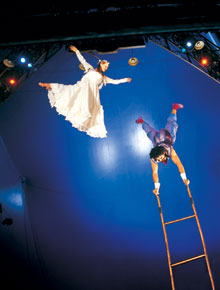
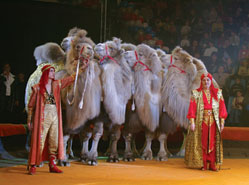
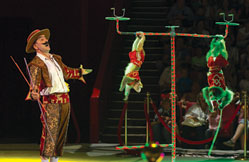
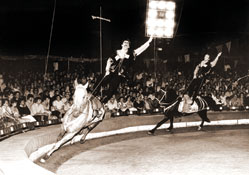
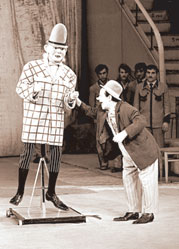
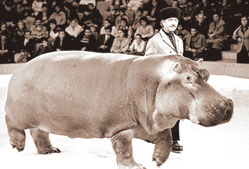
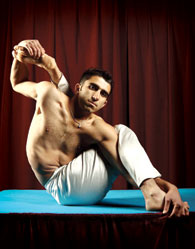

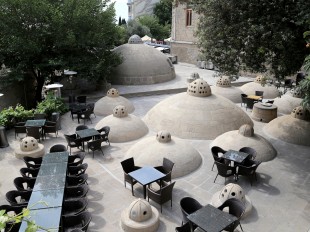
.jpg)